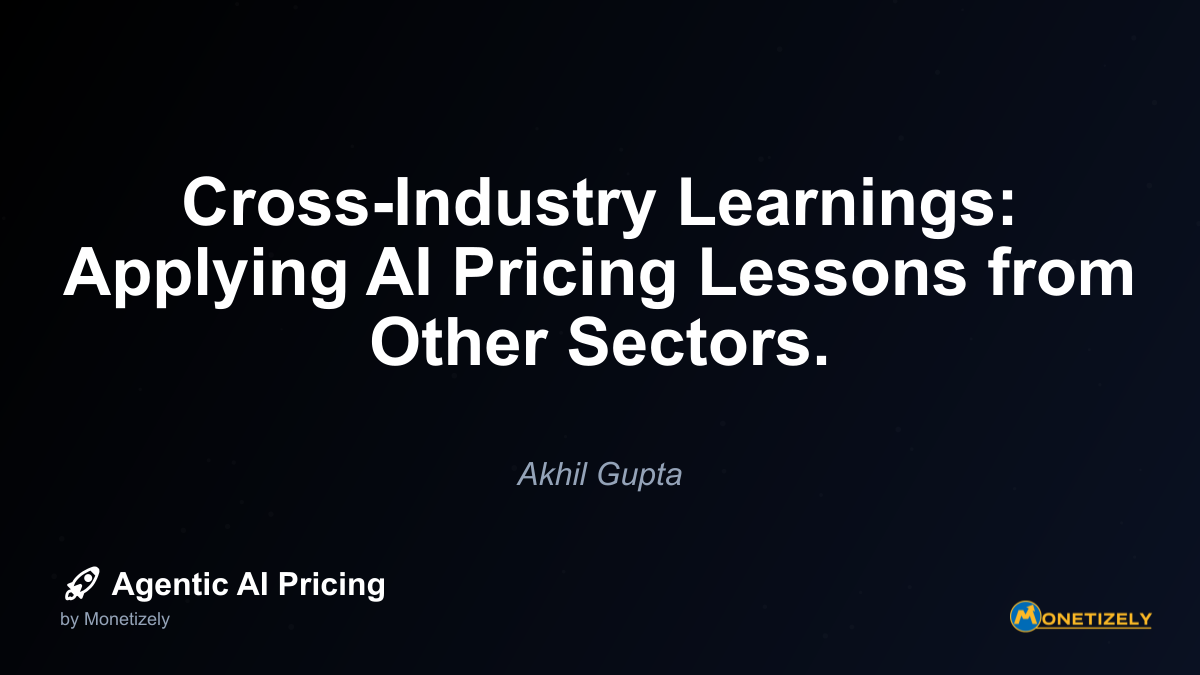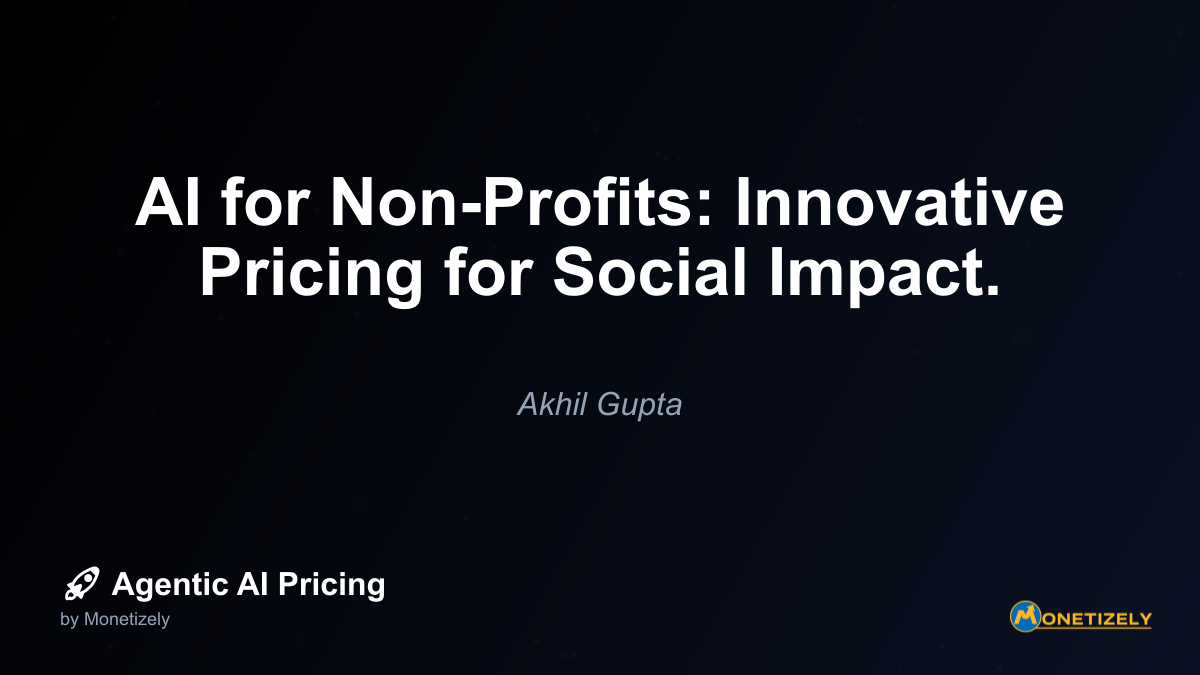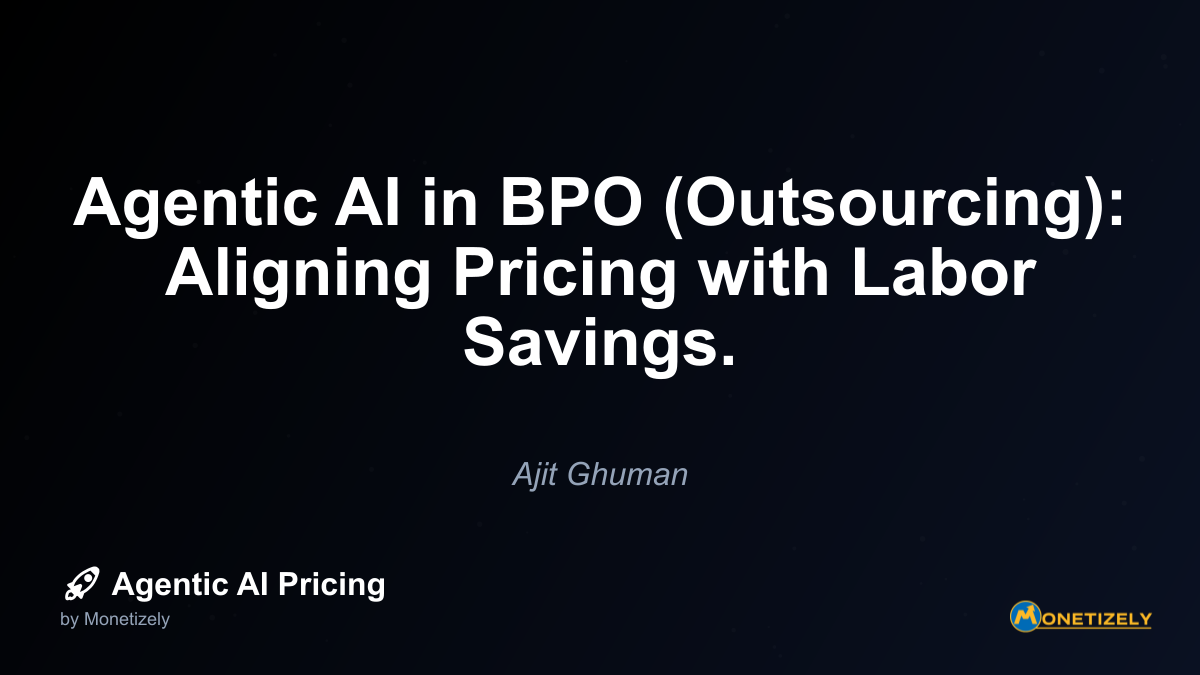· Akhil Gupta · Industry Insights · 6 min read
Cross-Industry Learnings: Applying AI Pricing Lessons from Other Sectors.
AI and SaaS Pricing Masterclass
Learn the art of strategic pricing directly from industry experts. Our comprehensive course provides frameworks and methodologies for optimizing your pricing strategy in the evolving AI landscape. Earn a professional certification that can be imported directly to your LinkedIn profile.

Promising Models for Cross-Industry Adaptation
When evaluating which pricing models might translate well across industries, several approaches stand out for their adaptability:
Outcome-Based Pricing Models
As explored in our article on outcome-based versus time-based pricing for AI services (target=“_blank”), outcome-based approaches represent one of the most transferable pricing innovations. This model directly ties payment to measurable results, creating a natural alignment between vendor and client incentives.
The beauty of outcome-based pricing is its inherent flexibility across sectors. The specific outcomes change—reduced downtime in manufacturing, improved diagnostic accuracy in healthcare, higher conversion rates in marketing—but the core pricing principle remains consistent.
Key adaptation considerations include:
- Identifying appropriate outcome metrics for your specific industry
- Establishing reliable measurement methodologies
- Determining appropriate pricing benchmarks for different outcome levels
- Creating contractual frameworks that protect both parties
Usage-Based Pricing with Industry-Specific Metrics
Usage-based pricing models can be effectively transplanted across industries by adapting the usage metrics to reflect industry-specific value drivers. A financial services AI might charge per transaction analyzed, while a healthcare AI could charge per patient record processed, and a manufacturing AI per production hour optimized.
The core principle—aligning price with consumption—remains intact while adapting to how different industries conceptualize and measure usage. This model has proven particularly effective when moving from data-intensive industries like financial services to other sectors like healthcare or logistics.
Hybrid Subscription Models
Hybrid subscription models combine a base subscription fee with variable components tied to usage or outcomes. This approach, pioneered in enterprise software, has been successfully adapted across numerous AI sectors.
The model’s flexibility makes it particularly amenable to cross-industry adaptation. The base subscription provides stable revenue while the variable components can be customized to industry-specific value drivers. Manufacturing AI providers might add variable components based on production volume, while marketing AI platforms might tie variable pricing to campaign performance.
Industry-Specific Adaptation Considerations
While cross-industry pricing adaptation offers tremendous opportunities, successful implementation requires understanding unique industry characteristics:
Healthcare AI Pricing Adaptations
Healthcare presents distinct challenges for pricing adaptation:
- Regulatory considerations: Pricing models must comply with healthcare regulations like anti-kickback statutes
- Budget cycles: Healthcare organizations often operate with rigid annual budgets
- ROI timeframes: Benefits may take longer to materialize compared to other industries
- Stakeholder complexity: Multiple decision-makers with different priorities influence purchasing
When adapting pricing models to healthcare, consider longer contract terms, phased implementation approaches, and ROI guarantees that accommodate the industry’s longer decision cycles and complex stakeholder environment.
Financial Services AI Pricing Adaptations
Financial services adaptations require attention to:
- Compliance requirements: Models must accommodate regulatory requirements around transparency and fairness
- Risk sensitivity: Pricing should reflect the industry’s risk-averse nature
- Scale variations: Solutions must work for institutions of dramatically different sizes
- Data security premiums: Enhanced security requirements may justify premium pricing
Successful adaptations to financial services often include tiered pricing based on institution size, compliance-focused feature sets, and risk-sharing components that address the industry’s conservative approach.
Manufacturing AI Pricing Adaptations
Manufacturing adaptations should consider:
- Production volume variability: Pricing should accommodate seasonal or cyclical production changes
- Integration complexity: Implementation costs vary widely based on existing systems
- ROI visibility: Clear connections to reduced downtime or improved yield are essential
- Capital vs. operational expenditures: Preference for OpEx over CapEx models
Effective manufacturing adaptations often include pricing tied to production volume, phased implementation options, and ROI guarantees tied to specific operational metrics.
How to Identify Cross-Industry Pricing Opportunities
Discovering relevant cross-industry pricing innovations requires a systematic approach:
Follow pricing innovation in adjacent industries: Regularly review how AI solutions in adjacent sectors are evolving their pricing models.
Study industry disruptors: Companies disrupting traditional industries often pioneer innovative pricing approaches worth studying.
Examine parallel value propositions: Identify companies in other sectors with similar value propositions, even if the specific applications differ.
Monitor investor perspectives: Venture capital and private equity firms often have cross-industry visibility and can identify emerging pricing trends.
Analyze customer migration patterns: When customers move between industries, they often bring pricing expectations with them.
Participate in cross-industry forums: Industry-agnostic AI conferences and communities often showcase pricing innovations that transcend sector boundaries.
Implementation Roadmap for Cross-Industry Pricing Adaptation
Successfully transplanting a pricing model from another industry requires a structured approach:
Research and selection: Identify promising models from other industries that address similar challenges.
Industry-specific adaptation: Modify the core model to accommodate your industry’s unique characteristics.
Stakeholder education: Prepare internal teams and customers for the new approach with clear communication.
Limited pilot testing: Test the adapted model with a small customer segment before broader rollout.
Feedback collection and refinement: Gather structured feedback to identify necessary adjustments.
Phased implementation: Roll out the new model in stages, allowing for continuous refinement.
Performance monitoring: Establish clear metrics to evaluate the adapted model’s effectiveness.
Common Pitfalls in Cross-Industry Pricing Adaptation
While cross-industry adaptation offers significant opportunities, several common pitfalls should be avoided:
Surface-level copying: Implementing the visible aspects of a pricing model without understanding the underlying principles.
Ignoring industry context: Failing to adapt the model to industry-specific constraints and customer expectations.
Underestimating change management: Not preparing customers and internal teams for the new approach.
Rigid implementation: Treating the adapted model as fixed rather than a starting point for continuous refinement.
Overlooking competitive response: Not anticipating how competitors might react to the innovative pricing approach.
Misaligned incentives: Creating unintended consequences through poorly adapted incentive structures.
Future Trends in Cross-Industry AI Pricing
Several emerging trends are likely to shape cross-industry pricing adaptation in the coming years:
Ecosystem-based pricing: Models that price based on value created across entire business ecosystems rather than for individual organizations.
Dynamic pricing algorithms: AI-powered pricing systems that continuously optimize pricing based on multiple variables.
Risk-sharing partnerships: More sophisticated outcome-based models where vendors take on greater risk in exchange for higher upside potential.
Sustainability metrics: Incorporation of environmental and social impact metrics into pricing models across industries.
Micro-transaction models: Granular, API-based pricing approaches pioneered in developer services expanding to other AI applications.
Conclusion: The Competitive Advantage of Pricing Cross-Pollination
In the rapidly evolving agentic AI landscape, pricing innovation represents a significant competitive advantage. Organizations that successfully adapt proven pricing models from other industries can gain substantial first-mover benefits while avoiding the costly trial-and-error process of developing entirely new approaches.
The most successful AI companies will be those that look beyond their immediate competitive landscape, systematically evaluating pricing innovations from across the business spectrum. By thoughtfully adapting these models to their specific industry contexts, they can create pricing approaches that better align with customer value, accelerate adoption, and capture appropriate returns on their AI investments.
As AI continues to transform industries at an accelerating pace, the cross-pollination of pricing strategies will become increasingly important. The organizations that master this discipline—systematically identifying, adapting, and implementing pricing innovations from diverse sectors—will enjoy a significant competitive advantage in the AI-driven future.
The next time you’re evaluating your AI pricing strategy, ask yourself: What successful pricing innovations from other industries might we adapt to create more value for our customers and our business? The answer could be the key to unlocking your next phase of growth.
Co-Founder & COO
Akhil is an Engineering leader with over 16+ years of experience in building, managing and scaling web-scale, high throughput enterprise applications and teams. He has worked with and led technology teams at FabAlley, BuildSupply and Healthians. He is a graduate from Delhi College of Engineering and UC Berkeley certified CTO.
Pricing Strategy Audit
Let our experts analyze your current pricing strategy and identify opportunities for improvement. Our data-driven assessment will help you unlock untapped revenue potential and optimize your AI pricing approach.




